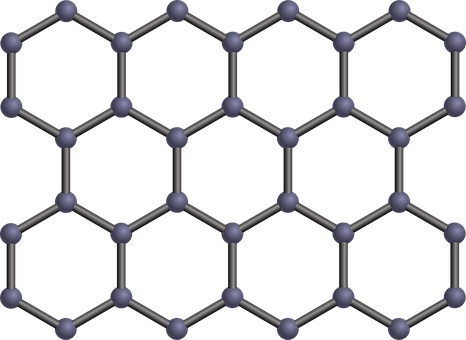Graphene

|
| Graphene's hexagonal lattice of carbon atoms. |
Graphene is an allotrope of carbon and at 200 times stronger than steel it is also the strongest material known. It is formed by a hexagonal lattice of carbon atoms with a thickness of a single atom. It is the most thermally- and electrically-conductive manufactured material.
Single-layer carbon foils were described in 1962 by Hans-Peter Boehm. However, graphene was isolated in the physics department of the University of Manchester, England in 2004 by Prof Andre Geim and Prof Kostya Novoselov. The pair won the Nobel Prize in 2010 for their pioneering work in Physics.
Graphene was isolated by the pair using a lump of graphite and some common sticky tape. Although the sticky-tape method is still used, it cannot be replicated at an industrial scale which means other methods must be used that can produce the material in greater quantities. For example, one of the numerous industrial methods is to ‘grow’ graphene on hot copper- or nickel-foil; or, when graphite is immersed in water it is exfoliated and results in an inky liquid that contains particles of graphene floating around in suspension.
Scaling-up these methods to produce greater quantities of graphene is ongoing work.
[edit] Applications
Graphene has remarkable properties and enormous potential, of which only a fraction has yet been realised. The global market for graphene was estimated at US42.8 million in 2017 and is expected to experience a compound annual growth rate of around 38% up to 2025. The material is regarded as a disruptive technology that could replace existing technologies and in so doing, create new markets. Typical areas of application include transport, energy, electronics, medicine, desalinisation and defence.
Graphene is flexible and therefore makes possible products such as bendable electronics – mobile phones, laptops and computer screens.
The potential of graphene is generally realised by combining it with other materials to create composites (i.e a combination of two or more constituent materials which result in a product that offers benefits which are greater than the sum of the two individual products). One example formulated by researchers at the University of Manchester is a graphene and paint combination, resulting in a coating that it is claimed could signal the end for rust on ships, containers and cars, and may also be applied to brick and stone for weatherproofing purposes. However, one limitation is that at the time of writing, the paint can only be made in black.
Another area is the development of membranes which can filter out harmful elements using graphene filtration. Graphene oxide membranes have highly effective separation qualities that could, for example, see carbon dioxide removed from flue gases at power stations, something that is not done on any great scale at present. Creating membranes which achieve that is a potentially enormous market.
Other applications of graphene-based composites exist in the transport and aerospace industries. One possibility is a graphene-composite aircraft wing which would be much lighter than the conventional wing type and so increase an aircraft’s fuel efficiency and range, and would also mean the plane would be less prone to lightning strikes.
[edit] Related articles on Designing Buildings Wiki
Featured articles and news
RTPI leader to become new CIOB Chief Executive Officer
Dr Victoria Hills MRTPI, FICE to take over after Caroline Gumble’s departure.
Social and affordable housing, a long term plan for delivery
The “Delivering a Decade of Renewal for Social and Affordable Housing” strategy sets out future path.
A change to adoptive architecture
Effects of global weather warming on architectural detailing, material choice and human interaction.
The proposed publicly owned and backed subsidiary of Homes England, to facilitate new homes.
How big is the problem and what can we do to mitigate the effects?
Overheating guidance and tools for building designers
A number of cool guides to help with the heat.
The UK's Modern Industrial Strategy: A 10 year plan
Previous consultation criticism, current key elements and general support with some persisting reservations.
Building Safety Regulator reforms
New roles, new staff and a new fast track service pave the way for a single construction regulator.
Architectural Technologist CPDs and Communications
CIAT CPD… and how you can do it!
Cooling centres and cool spaces
Managing extreme heat in cities by directing the public to places for heat stress relief and water sources.
Winter gardens: A brief history and warm variations
Extending the season with glass in different forms and terms.
Restoring Great Yarmouth's Winter Gardens
Transforming one of the least sustainable constructions imaginable.
Construction Skills Mission Board launch sector drive
Newly formed government and industry collaboration set strategy for recruiting an additional 100,000 construction workers a year.
New Architects Code comes into effect in September 2025
ARB Architects Code of Conduct and Practice available with ongoing consultation regarding guidance.
Welsh Skills Body (Medr) launches ambitious plan
The new skills body brings together funding and regulation of tertiary education and research for the devolved nation.
Paul Gandy FCIOB announced as next CIOB President
Former Tilbury Douglas CEO takes helm.
UK Infrastructure: A 10 Year Strategy. In brief with reactions
With the National Infrastructure and Service Transformation Authority (NISTA).






















